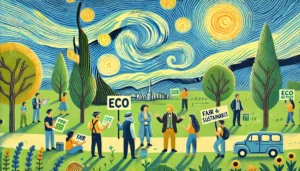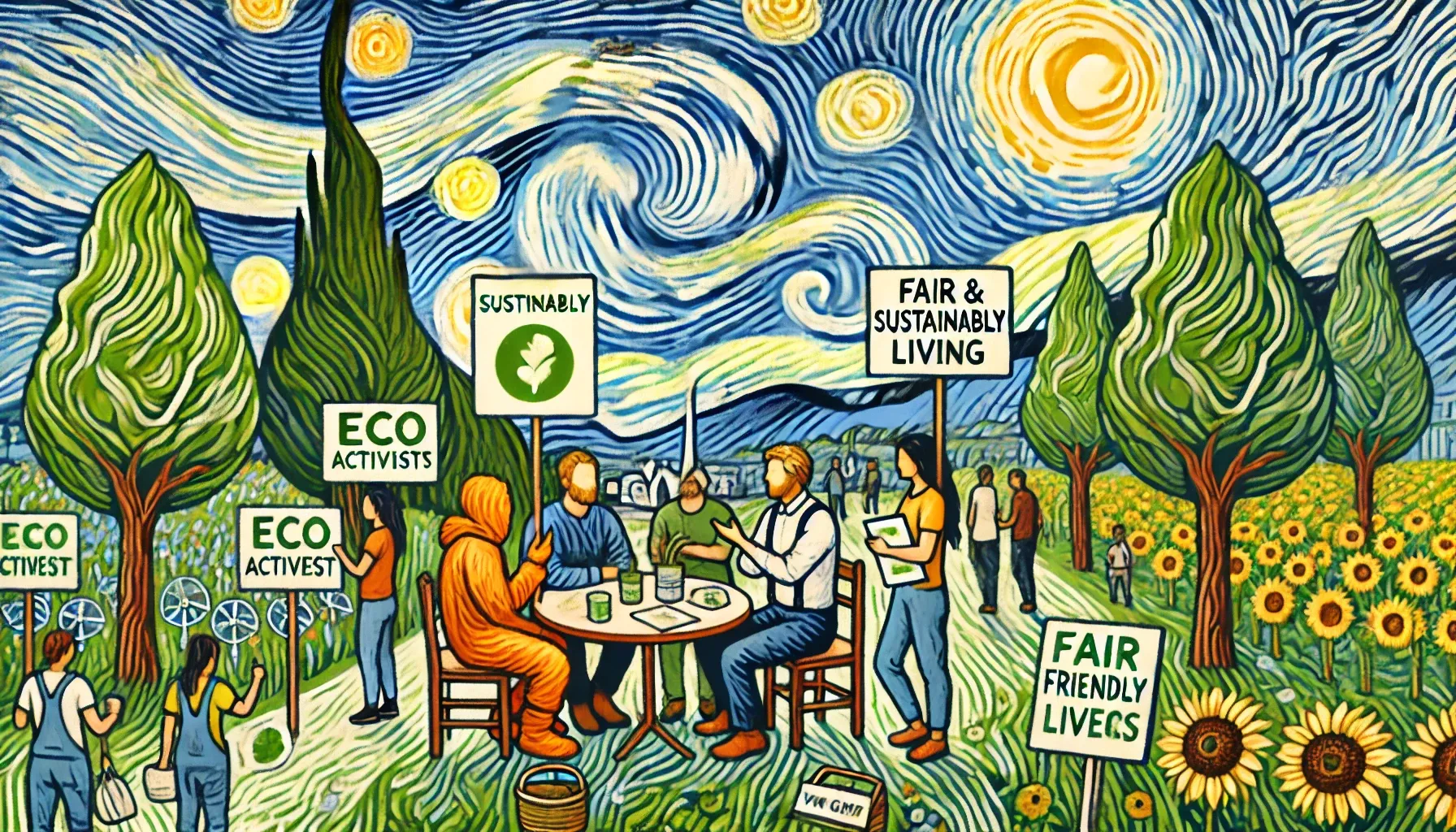The urgency with which we need to address climate change and environmental sustainability in recent years has seen some innovative new ways eco activists are trying to make the world a healthier, safer, more responsible place. Of these, the art – addressing activism continuum has provided a particularly potent means to communicate ideas and evoke change. And most recently, the lasting influence of Vincent van Gogh in eco-activism. If we take a closer look at how Van Gogh inspires contemporary environmental activists, then it becomes hopefully clearer how art might play in fostering a fair sustainability debate.
The Intersection of Art & Environmental Activism
Human creativity has had a checkered relationship with artistic expression, and art in return is no longer distant from human group identity. Art, in the realm of environmental activism offers us a vehicle not only to convey messages about emerging ecological matters but it also allows for an exploration of what could be – glimpses into ideas around sustainability. With art that has such high emotional and aesthetic power, we can transcend language barriers to reach people on a visceral level which is an effective mechanism for conscious raising and activism.

Was Vincent van Gogh an Environmental Prophet?
While Vincent van Gogh is widely considered a post-impressionist, his work additionally reveals great links to nature. An 1890 painting of his, ‘The Starry Night’, along with other works where Van Gogh turns his eye towards the love of a nature-filled life (‘Sunflowers’ and ‘Wheatfield with Crows’) splendor as seen quite clearly from behind closed shutters. Bold colors and dynamic brushwork bring to life the landscapes, flora, rural scenes that speak of his worship for nature.
In a series of letters he wrote to his brother Theo and other correspondents, Van Gogh expresses sadness with regard to deforestation, the season changing outside of him reflecting on it from within. Even though he never called himself an environmentalist, his art and writings echo the present day themes of sustainability and conservation.
Life Imitating van Gogh as Eco Warriors
Van Gogh’s ability to evoke emotion and his unmistakable style make him a popular choice for modern eco activists who are eager to use the power of art in arguing their environmental stewardship messages. The campaigners weave the backdrop of Van Gogh into a poignant narrative that merges art history with mirroring contemporary ecological crises.
Case Studies: Van Gogh Environmental Campaigns
- The Van Gogh Alive Experience
Considered the first large-scale experience of its kind to combine an exhibition and digital technology, “Van Gogh Alive,” which has traveled around the world, offers a sensory exhibit through Van Gogh masterpieces. Eco activists too have used the platform, juxtaposing Van Gogh’s representations of nature with harsh visuals from environmental degradation. They do so in order to distance themselves from the melodrama inherent in a lot of nature porn and, instead, transform it into an evocative experience that will inspire people to control their love for what remains wild.
- Sunflowers for Sustainability
Environmental organizations re-interpret Van Gogh’s Sunflowers series as representing sustainability projects. Community gardening projects and urban green spaces are adorned with the sunflower, promoting biodiversity and how to live in a greener way. There is often a didactic side to these initiatives – one that typically points toward the importance of individual action in promoting environmental stewardship; also, linking such favorably with Van Gogh’s scrupulous study of nature notes.
- Eco Art Installations
The works of Van Gogh have also been the subject of several large-scale installations made by contemporary artists and activists as a way to draw attention to climate change, ecological collapse. Many of these installations double as community centers, equipped with solar energy and recycled building materials (Mansoor 2011), highlighting the importance of sustainable development. Through turning public spaces into installations, artivist murals – works of media that compel relevant social actions and attention to an environmental cause.
Critique of Eco-Activist Movements
Although the blend of art and activism is very effective, as history shows us, it also has its own set of struggles – with many claiming that political responsibilities are a distraction from the craft. All these issues are extremely important for the establishment of equal dialogue and help solve real problems with sustainability!
Greenwashing and Authenticity
Art-based eco activism is often criticized as it could easily be employed by companies and organizations for greenwashing (a form of spin where marketing people may present an unwarranted positive image) without actually doing anything to recycle or create sustainable change. Therefore, eco activists need to make sure that their campaigns are not just environmentally abusive themselves.
Accessibility and Inclusivity
The kind of activism we have to do with art must also fight for everyone can be part. Marginalized communities, however, may not be able to access high profile exhibitions and installations because of the cost or location. Eco Activists need to work on making their messages accessible for all demographics such as through community-based projects, e-media platforms or in collaboration with local artists.
Finding a Work Life Balance & Activism
A contentious question where art vs activism is concerned. One school of thought contends that the art should remain pure and not be manipulated by activist goals, another group takes a more broad-minded attitude arguing that the crisis at hand allow for didactic solutions. For e-activists, that requires striking a balance between accessibility – which resonates with the general public and being able to communicate what they want to say.
How to use Art for Eco Activism
In order to do this, eco activists can use a variety of approaches themselves in their communication efforts.
- Collaboration & Service to the Community
Working with artists, local groups and environmental organizations can help to broaden the impact of eco-activist work. This allows activists to create and share their projects with a multitude of stakeholders – contributing to greater ownership and collective accountability for environmental concerns.
- Leveraging Digital Platforms
The Reach Online With the help of digital technology, new opportunities for art-based activism have emerged considerably. This platform is suitable for connecting with social media and reachable to a broader audience globally which will provoke many human beings from throughout the world also it helps in simple interaction part as virtual exhibitions are taken place over online. People are responsible for spreading their messages through these platforms, so activists should use them to spread the word about contact and a shared global conscience.
- Educational Initiatives
Including educational components with art-based activism can inform the public and perhaps bring about change that has a lasting impact. Things like workshops, lectures and interactive displays can provide the context as well as steps for someone to take action towards sustainability. Art serves as a tool for education, and in turn, activists combine art with their cause to incite an informed public which is then further empowered.
- Creating Art in a Sustainable Way
If eco activists want to keep their credibility and authenticity they need focus on sustaining themselves. This involves the use of sustainable materials, waste reduction and lowering the carbon footprint in their projects. They reinforce the need for environmental responsibility by behaving in sustainable ways.
The Wider Impacts of Eco Activism and Art
This merging of art and eco-activism could be a powerful force for change in our understanding and behavior. Through the emotional and aesthetic through art, activists can inspire a more powerful connection to nature and greater commitment to sustainability. However, this strategy can also be a precursor to larger societal changes in attitudes toward the environment.
Shaping Policy and Public Opinion
It remains one of us, but art-based eco activism will do nothing on the formality or the policy. All this can make them enter public imagination and gain media coverage that can push environmental issues higher up the political agenda. Lastly, our activists need to work with policymakers in strategic ways and leverage their projects for better environmental laws.
Fostering Global Solidarity
In turn, environmental problems are global by nature and therefore need transnational approaches. Art can bridge all barriers including culture, language and develop global solidarity. Eco activists often employ some form of artistic expression, to tell stories and paint pictures that reflect the reality or potential loss because most environmental work is not about new beginnings but rather saving what remains.
Building a Sustainable Culture
At the end of the day, eco activism would like to achieve a sustainability culture where environmental stewardship is as integral in society. Art can be a driving force in this transformation of our culture, helping to make sustainability something we feel deeply and want for ourselves & others. By continuously engaging and innovating, eco activists are the ones who can help build a more sustainable & resilient world.
Conclusion
And how Vincent van Gogh’s art achieves new impact when being reframed and interwoven in the context of current eco activism points to this transformative nature that surrounds personal artistic creativity within challenges presented by environmental urgencies. From the emotional and aesthetic impact of Van Gogh’s art, eco activists are in a position to craft effective counter-narratives that draw from powerful storytelling mechanisms which appeal to otherwise broader audiences mindful (western) channels for circulation. lopsided consumption habits- commonly understood as waste-ridden celebrations – manifest themselves here too. Noodling through the depths of this climate crisis web, it becomes necessary to imagine new ways in which we can have a participatory conversation that is equal and balanced around environmental sustainability. Since art is able to create emotional connections, we believe in the effective potential of Art as a mean to raise awareness and drive change towards environmental sustainability. Let us take the example of Vincent van Gogh, whose art enchants and empowers even today as we dare to imagine environmental sustainability through creativity. A world where through art and activism we can imagine a planet to pass on the beauty of nature for thousands more generations.
